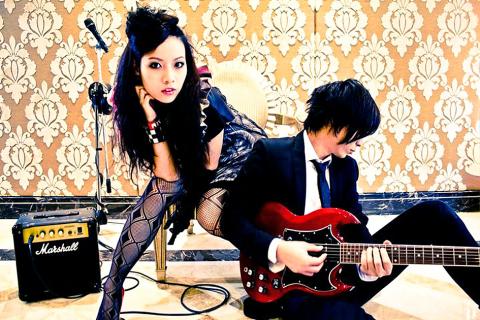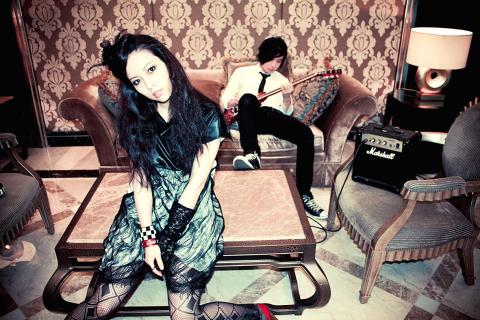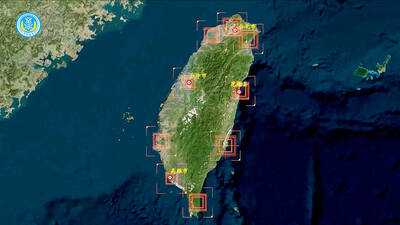Indie electronica/rock duo Astro Bunny (原子邦妮) is that rare thing: a band with a storyteller’s point of view.
The outfit will perform one set for its debut concert at Riverside Cafe (河岸留言) on Wednesday evening. The group is comprised of vocalist/lyricist Lena Cha (查家雯 a.k.a. 查查) — the former front-girl for the indie band Cherry Boom (櫻桃幫) — and bassist/producer Jay Cheng (程杰).
“We named the group ‘bunny’ because I love bunnies and I forced him to like them too,” Cha laughed in an interview with the Taipei Times three weeks ago. “I picked the word “astro” because I’m an anime and computer game geek.”

Photo courtesy of Astro Bunny
The group released its first EP What If There’s No Tomorrow (如果沒有以後) a month ago and will support the release with this concert.
“The astro bunny will lead you to a parallel universe where the ancient and the modern clash in a musical atmosphere,” Cha said, explaining that their electronica is crafted through the juxtaposition of literary ancient Chinese prose and contemporary electronica melodies. The resulting music is a combined composition.
“Because of the neutral nature of the synthesizer used to create electronica sounds, this seemingly lifeless music doesn’t feed you with predetermined themes,” Cha explained. “Rather, it allows you to interpret and imagine meanings according to your mood at the time.”

Photo courtesy of Astro Bunny
The five-track EP is conceived as a concept album and a storybook. The Intro depicts the beginning when nothing exists. Then an explosion takes place, followed by the track The Milky Way (銀河). With the title track What If There’s No Tomorrow, the two imagine the apocalypse of 2012, but resolve to hold on to their love. Flower Blossoms and Moon Round (花好月圓) was originally written by Cheng for indie icon Sandee Chan (陳珊妮) but is transformed into an electronica gem with literary lyrics. The closing track That Day (那天) is an electronica ballad about encountering a former lover and reminiscing about what might have been.
“Electronica is a form that demands a mixture of visual and musical presentation,” Cha said. “We want to bring video artists, VJs and lighting designers together to enhance the experience of our concerts in the future.”
On the cover and inside illustration of the EP there are photographs by Cha taken with an iPhone app that transforms them into designs. She plans to push this concept further to release a photo album with iPhone shots and also a storybook album.
“The possibilities of electronica are endless,” she said. The group plans to release its first full-length album at the end of this year.

The People’s Republic of China (PRC) last week offered us a glimpse of the violence it plans against Taiwan, with two days of blockade drills conducted around the nation and live-fire exercises not far away in the East China Sea. The PRC said it had practiced hitting “simulated targets of key ports and energy facilities.” Taiwan confirmed on Thursday that PRC Coast Guard ships were directed by the its Eastern Theater Command, meaning that they are assumed to be military assets in a confrontation. Because of this, the number of assets available to the PRC navy is far, far bigger

The 1990s were a turbulent time for the Chinese Nationalist Party’s (KMT) patronage factions. For a look at how they formed, check out the March 2 “Deep Dives.” In the boom years of the 1980s and 1990s the factions amassed fortunes from corruption, access to the levers of local government and prime access to property. They also moved into industries like construction and the gravel business, devastating river ecosystems while the governments they controlled looked the other way. By this period, the factions had largely carved out geographical feifdoms in the local jurisdictions the national KMT restrained them to. For example,

The remains of this Japanese-era trail designed to protect the camphor industry make for a scenic day-hike, a fascinating overnight hike or a challenging multi-day adventure Maolin District (茂林) in Kaohsiung is well known for beautiful roadside scenery, waterfalls, the annual butterfly migration and indigenous culture. A lesser known but worthwhile destination here lies along the very top of the valley: the Liugui Security Path (六龜警備道). This relic of the Japanese era once isolated the Maolin valley from the outside world but now serves to draw tourists in. The path originally ran for about 50km, but not all of this trail is still easily walkable. The nicest section for a simple day hike is the heavily trafficked southern section above Maolin and Wanshan (萬山) villages. Remains of

Shunxian Temple (順賢宮) is luxurious. Massive, exquisitely ornamented, in pristine condition and yet varnished by the passing of time. General manager Huang Wen-jeng (黃文正) points to a ceiling in a little anteroom: a splendid painting of a tiger stares at us from above. Wherever you walk, his eyes seem riveted on you. “When you pray or when you tribute money, he is still there, looking at you,” he says. But the tiger isn’t threatening — indeed, it’s there to protect locals. Not that they may need it because Neimen District (內門) in Kaohsiung has a martial tradition dating back centuries. On